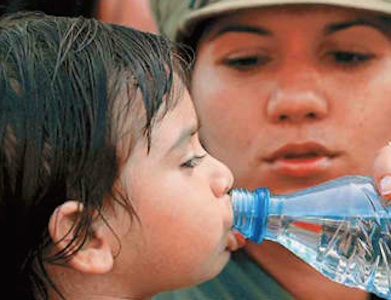

Drinking water and a upply kit ith non-perihable food, flahlight ith batterie, fully charged electronic, etc are important to have in bracing for major weather issue like a tropical storm or hurricane.
DAYTONA BEACH, Fla. -- With Tropical Storm Erika setting her sights on Florida, Volusia County’s emergency management officials remind residents to update or develop their disaster plans so all family members know what to do and what to expect.
Voluia County pokeoman Pat Kuehn shared those steps with HeadlineSurfer.com and other media outlets.
• Step 1: Discuss disasters as a family
Have a family meeting to talk about disasters. Children should be encouraged to talk about their fears, and parents should convey the steps they take to keep everyone safe. Together, develop a list of things to take care of in preparing.
• Step 2: Make evacuation plans
If you live in a storm surge evacuation area, determine where you would go if an evacuation order were given. It’s best to seek shelter at a family member’s or friend’s house or hotel outside the evacuation area. If leaving town, leave well in advance of an approaching storm. Shelters should be used as a last resort.
• Step 3: Inventory your valuables
Make a list and videotape/photograph items of value. Insurance policies should be reviewed well in advance of a storm. Once a hurricane watch has been issued, most insurers will not issue new or additional coverage, including flood insurance.
• Step 4: Check your home for vulnerable areas
Walk around your home and evaluate the roof, windows, garage doors, patio doors, screen enclosed rooms, landscaping, etc., to see what protective measures you need to take if a storm is approaching.
• Step 5: Protect your vehicles
Fill you tank before the storm hits. Identify where you would store or park your vehicle, boat or RV. Double-check your vehicle insurance policy and keep it in a safe place with your homeowner’s policy.
• Step 6: Reduce damage to your home and property
Consider installing window shutters, purchasing a generator and trimming trees. Double-check tie-down straps and anchors if you live in a mobile/manufactured home.
• Step 7: Identify special needs
Make arrangements to take care of infants, the elderly and those with special needs. Register people with special needs at www.volusia.org/emergency.
• Step 8: Have a plan for your pets
Make sure you have a plan to address your pet’s needs whether you evacuate or stay in your home. If you leave your pets home, make sure they have plenty of food and water. If you evacuate them to a pet-friendly shelter, bring proper identification. Also, remember to have a plan for large outdoor animals such as horses, cows and pigs.
• Step 9: Have a disaster supply kit ready
Make sure you have a week’s supply of nonperishable food, water and medical items for your family, along with a flashlight, batteries and a battery-operated radio. For more suggestions, visit www.volusia.org/disaster-supply.
• Step 10: Share your plan
Let your family, friends and coworkers know of your disaster plan. Make sure they know how to reach you to check on you. Have an out-of-town family member or friend as a point of contact.
Helpful Contacts
Volusia County Citizens Hotline: 866-345-0345
Florida Emergency Information Line: 800-342-3557
